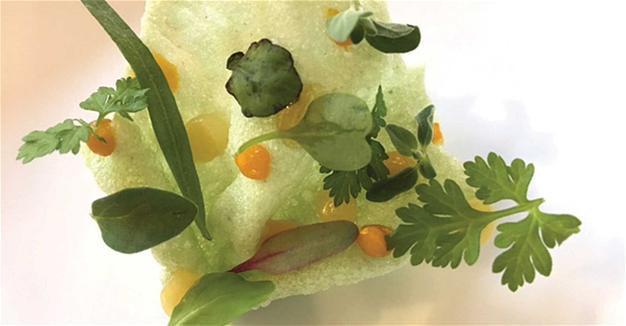‘L’ stands for Light and Lightness
Aylin Öney - Tan aylinoneytan@yahoo.com

The moment I stepped in the unassuming building, I felt like a feather floating in the air. The ambiance was very light and airy. All embraced in the lightness of white, the interior design of LUME makes one truly weightless, even slightly dizzy. A few moments later, I would witness the same effortless lightness in the dishes, with a strong stroke of sunshine.
The food of Luigi Taglienti is just as light and airy as the environment in which it is presented. Both the food and the interior design of the restaurant share the same sensation, so much that one can easily claim there is a food and design pairing here. LUME only opened last year in June, situated in a renovated old porcelain factory in Milan’s Navigli district. The restaurant was awarded with a Michelin star at the speed of light, in just six months. Awards followed and LUME has recently been announced as the Best New European Restaurant at the prestigious OAD (Opinionated About Dining) Awards, held in Paris in May.
Now in mid-summer, they have transformed their outdoor space into an al fresco dining area, rightly named “Orto di Lume,” “orto” meaning “a vegetable garden” in Italian. The new space has a natural flow from the closed area, playfully shaped like a huge birdcage and surrounded by sunny citrus trees in huge pots, vegetable and herb patches, all resonating the tastes that are omnipresent in Luigi’s plates. When asked about his inspirations, he refers to his homeland. Luigi is from Liguria. Of course everyone knows that Ligurian lemons are phenomenal and Ligurian’s love for basil is best represented in their world famous pesto sauce. Chef Taglienti trusts his talents to create his own signature dishes without deconstructing, re-visiting or interpreting old traditional recipes. Instead he uses his Ligurian memories as a taste palette to paint his own painting in the plate. The flavors and smells of Liguria are present in his plates, just as they surround the birdcage in Orto di Lume, the tender young vegetables and fresh herbs he used to pick for his grandma are there within reach, but the resulting plate that comes out of the kitchen is completely modern and new, just as the design of the space. Every detail in the design has a relation with the story of his cuisine, in a way his food is also reflected in the restaurant’s design.
Monica Melotti, the architect of the LUME, surely understands his style of cooking. Attention to detail, the finesse and precision in each plate are reflected in exactly the same way in the architecture of the space. As modern as it is, there is always a reminiscence of the past in its atmosphere, not only because the space is an old porcelain factory, but also because there is a touch of the past here and there, like the bread baskets and white lattice-work wall claddings getting their inspiration from the white laces of grandmas, the pure whiteness reminding of old bone china porcelain and so on. Some traditional items are creatively re-used, like the whitewashed traditional giant flowerpots turning them into a contemporary object.
Coming back to the food, Luigi Taglienti is a master of citrus flavors. There is always a dash of acidity in his plates, just the right amount, sometimes it is the bitters of citrus fruits, the peel of lemon, orange, mandarin, bergamot, pompelmo, or even stronger chinotto; sometimes the acidity is achieved by kiwi juice or a reduction of vinegar. He likes to add a touch of tanginess in his food. It gives a certain electricity that tantalizes the taste buds. Luigi Taglienti will be coming to Turkey towards the end of the year for the Gastromasa event in December, I promised to give him a crash course on sour Turkish condiments, all from sumac to pomegranate extract.
Just as I’m about to leave the luminous restaurant, I remember asking about what the name LUME stands for. Of course it comes from light, “luce” in Italian, meaning luminous, but he explains, “Before the restoration began, the space was all dilapidated and empty and when they first stepped into the building there was a strong beam of sunlight that came from the ceiling. That beam of light gave the inspiration for the name and the whole design.”
For me “L” stands not only for Lume, but also for lemons, Liguria and Luigi, and Luigi’s food is like that striking beam of light that shines through the ceiling, shedding light to the world of contemporary cuisine, with the sunny touch of Ligurian lemons.
Fork of the Week
Forks belong to the chef: At the age of 34, Luigi Taglienti was awarded with the “Tre Forchette” the prestigious three forks, by Gambero Rosso, the Italian answer to Michelin stars. When he started with Lume, many awards followed after receiving the first Michelin star. Other mentions include I Ristoranti d’Italia 2017 guide of L’Espresso’s New Restaurant of the Year and a score of “3 Cappelli,” Guida Alberghi&Ristoranti d’Italia 2017 guide of the Italian Touring Club’s “Cucina D’autore” award and I Cento Milano 2017 guide’s New Restaurant of the Year.
 The moment I stepped in the unassuming building, I felt like a feather floating in the air. The ambiance was very light and airy. All embraced in the lightness of white, the interior design of LUME makes one truly weightless, even slightly dizzy. A few moments later, I would witness the same effortless lightness in the dishes, with a strong stroke of sunshine.
The moment I stepped in the unassuming building, I felt like a feather floating in the air. The ambiance was very light and airy. All embraced in the lightness of white, the interior design of LUME makes one truly weightless, even slightly dizzy. A few moments later, I would witness the same effortless lightness in the dishes, with a strong stroke of sunshine.